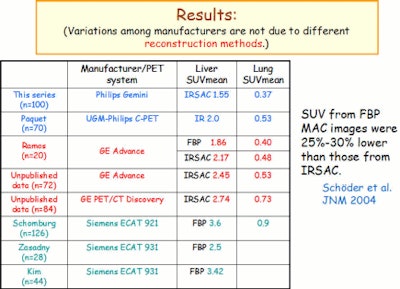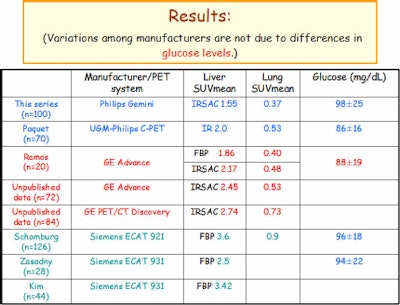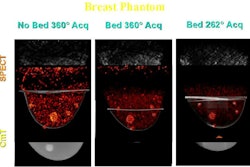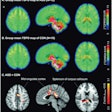
Researchers at the University of Maryland School of Medicine in Baltimore have found that standardized uptake values (SUVs) vary in PET systems manufactured by different vendors.
SUVs are one of several factors used to help distinguish malignant and benign etiologies, the most common of which is in the diagnosis of lung nodules. "There are multiple factors which are known to cause variations in SUV, including body weight, plasma glucose level, uptake period, and reconstruction method," said Dr. Chun K. Kim, a professor in the school's department of diagnostic radiology.
Having seen differences in images and SUVs, as reported in other studies, the researchers "suspected for some time" that the SUV calculated from their machine (Gemini PET system, Philips Medical Systems, Andover, MA) is lower than that of other systems.
"The aim of our study was to examine the magnitude of variation in SUVs among PET systems from different manufacturers," said Kim, who presented the group's results at the 2007 SNM meeting in June in Washington, DC.
Study protocol
The University of Maryland study reviewed 100 consecutive patients with various cancers. The 40 women and 60 men ranged in age from 7 to 94 years, with a mean age of 55 years. Under the imaging protocol, patients fasted for at least four hours, and imaging began 45 to 60 minutes after FDG injection. Emission scans were obtained for three minutes per bed position, while transmission using cesium-137 was done for one minute per bed position.
For the SUV comparisons, the researchers, who also used iterative reconstruction with segmented attenuation correction (IRSAC), chose two body organs with no pathology and representing both relatively low SUV (lung) and relatively high SUV (liver). They also focused on the midcoronal section and two regions of interest. "Special care was taken not to include any suspicious hot spots," Kim added.
The school's SUVs were compared to SUVs of the lung and liver in other research papers, and normalized for body weight. "If there were two SUVs reported in a paper calculated at different time points," Kim noted, "we used the average of the two values for the comparison."
In its findings, the team eliminated reconstruction methods as a potential source for the SUV variations, citing one study in which SUVs from filtered backprojection (FBP) measured attenuation correction were 25% to 30% lower than SUVs from IRSAC (see chart below).
 |
| All charts courtesy of Dr. Chun K. Kim, University of Maryland School of Medicine. |
"Clearly, reconstruction method is one of the factors that influence SUV value," Kim said. "That being said, could this difference be due to a difference in methodology or reconstruction? Probably not, because the FBP would produce low SUV. Yet, the SUV for Siemens' (ECAT) was the highest -- 3.6 and 3.4. That probably did not explain the different SUVs from different manufacturers."
Kim also eliminated glucose levels and uptake period in the SUV comparisons with different PET systems.
 |
 |
Even when glucose levels were similar, SUV levels varied between different PET systems. When imaging times -- the uptake period after FDG injection -- were similar, there remained what Kim described again as "a significant difference" in SUVs (see charts above).
Given the results, the researchers concluded that high SUV variation exists among PET systems from different manufacturers. While vendors may have corrected the discrepancies, the "'take home' message is that whenever you want to adopt any criteria using SUV values published by authors and using other PET systems, you should be careful and run a phantom study and note any error in calibration factors in your systems," Kim said.
The potential variation between different PET systems also should be kept in mind when the SUV is relied upon to distinguish between malignant and benign lung nodules, or when adopting any criteria using others' SUV published data, he added.
By Wayne Forrest
AuntMinnie.com staff writer
July 25, 2007
Related Reading
FDG uptake correlates with survival, biomarkers in NSCLC, June 19, 2007
Lung tumor's maximum PET isotope uptake predicts stage, outcome, August 17, 2005
Copyright © 2007 AuntMinnie.com



















